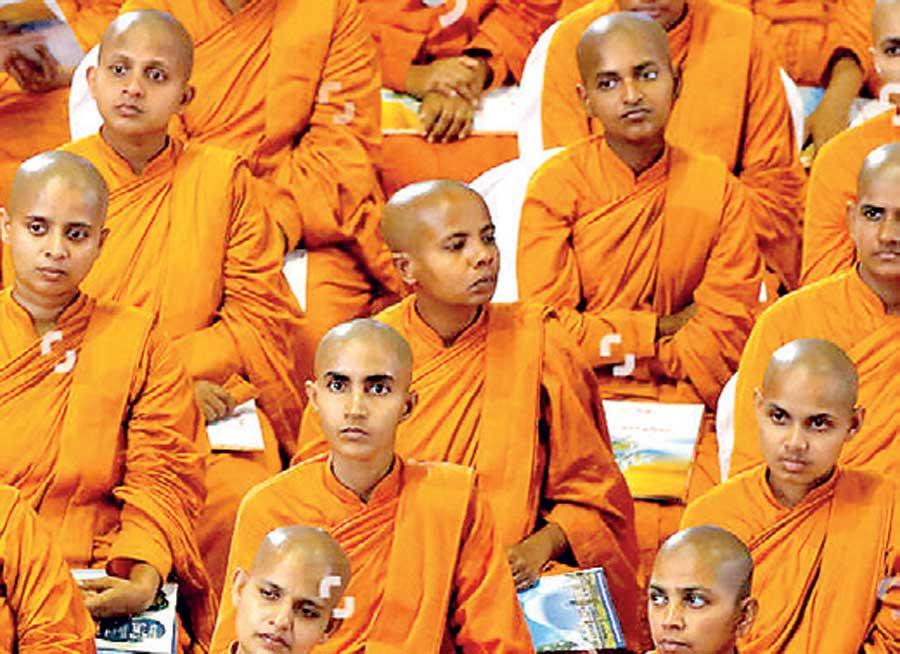20 Sep 2021 - {{hitsCtrl.values.hits}}

It was on a Binara Full Moon Poya Day, that the Bhikkuni Order was established by the Buddha Himself. The Bhikku Order was already flourishing having commenced around seven years earlier and the Ordination of women would not have been possible if not for the determination of Queen Maha Prajapathi Gothami, Buddha’s stepmother.
Bhikku Order was already flourishing having commenced around seven years earlier and the Ordination of women would not have been possible if not for the determination of Queen Maha Prajapathi Gothami, Buddha’s stepmother.
It was however, no easy task for Queen Prajapathi. This was an era when women were considered inferior in the then Indian society and the granting of equal opportunities with men was unthinkable.
However, Queen Prajapathi, after the death of King Suddhodhana, set out accompanied by five hundred Sakya and Koliya Royal women and sought permission from the Buddha to enter the Bhikkuni Order – a request the Buddha turned down. It was too radical a step to endorse a transition from home to homelessness.
It was however, on the fourth occasion when Prajapathi Gothami and her band of women arrived in saffron robes, wailing with heads shaven and soles bleeding due to having walked barefooted all the way to Vesali from Kapilavasthu where the Buddha at the time resided, that she accomplished her objective. The achievement was made possible through the determined intervention of Ananda Thero who queried from the Buddha whether women were equally capable of achieving full awakening? The Buddha agreed that women had the same potential for full awakening and let go of any misgivings about His stepmother and the others renouncing their privileged life to become Dhamma practitioners.
Why did Buddha hesitate to give ordination to women? He said “If Ananda, women do not enter houselessness from household life, the religion under the Doctrine and the Discipline announced by the Thathagatha, would endure 1000 years. If He accepted, Dhamma will disappear 500 years earlier.” The prophecy was made when Ananda Thero, moved by the earnestness of Prajapathi Gothami and others, begged the Buddha to ordain them.
When He ultimately granted it on a Binara Full Moon Poya Day, Buddha laid down eight additional rules or “Garu Dhamma” for the bhikkunis, thus going beyond those imposed on monks. Most of these which pertain to interactions with the monks, set them hierarchically below monks, an act which may have been imposed as a disincentive for them to enter the Order.
Buddha’s initial objections had been criticized with allegations of chauvinism on the part of the Buddha. But a deeper study reveal that the new turn of events may have been of great worry to the Buddha. Who would give these wondering women places to live? Maha Prajapathi was virtually His mother and she had been living in the comfort of a Royal Palace. Could she suddenly find herself living the life of a recluse?
And women wanderers could be vulnerable on the roads while a mixed Sangha would lead to suspicion among the lay people.
In those early days, there were not enough monasteries even for monks. Some therefore lived under trees, caves and in the most unimaginable places. And monks went from house to house with the begging bowl to collect alms. The collection could amount to just a handful of food and what would happen when five hundred women go out begging for alms?
Buddha had already been criticized that with the establishment of the Bhikku Order, He had destroyed the family unit. In ancient India, the family was a rigid institution. Women had never left home and lived a life of their own. However, He later learnt that husbands of most of these royal women had joined the Bhikku Order leaving behind their wives at home.
Buddha also needed to examine whether women were capable of achieving spiritual enlightenment. To afford it to bhikkunis, competent teachers were needed to teach the Doctrine and to train them. The Sangha were not ready yet to handle such a large crowd of bhikkunis. Not only should they teach but special skills were required to help uplift women spiritually. Later, with the development of propagation of Buddhism, educational and training programmes were established when trained bhikkus were assigned with the teaching and training tasks.
Doors were thus opened to women for spiritual nourishment when enlightenment was made possible for all human beings. With the forming of the Bhikkuni Order 7-8 years following the Bhikku Order, Buddha made it clear that both bhikkus and bhikkunis possessed equal potential to achieve spiritual enlightenment.
If not for the stern determination of Prajapathi Gothami however, Buddha, who was in two minds on the setting up of the Bhikkuni Order, may never have granted ordination to women. And by doing so, He facilitated the world’s first liberation movement for women who were till then denied the same choice as men.
19 Apr 2024 4 hours ago
18 Apr 2024 5 hours ago
18 Apr 2024 6 hours ago
18 Apr 2024 6 hours ago
18 Apr 2024 7 hours ago